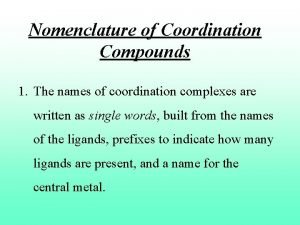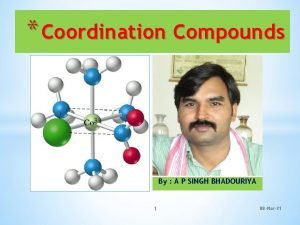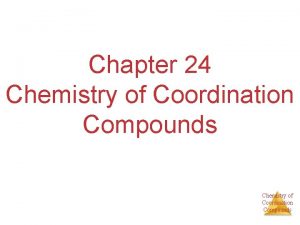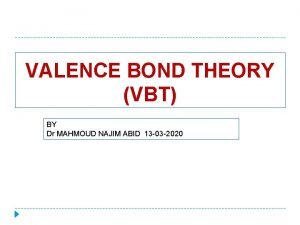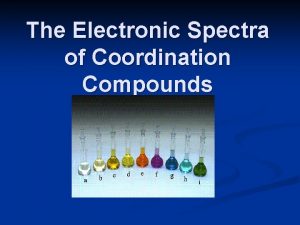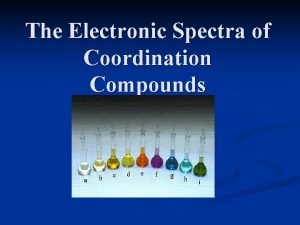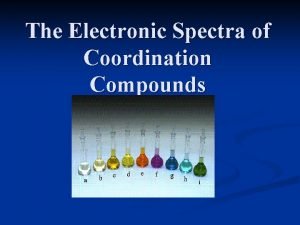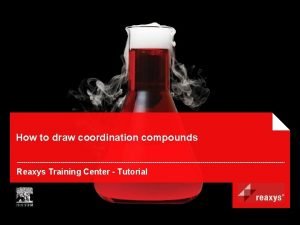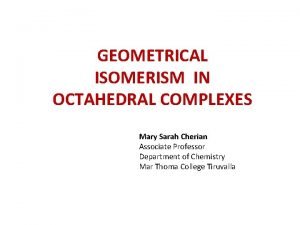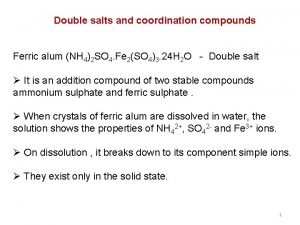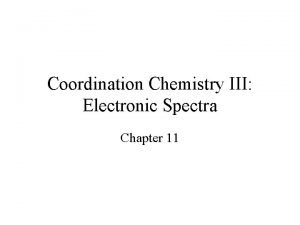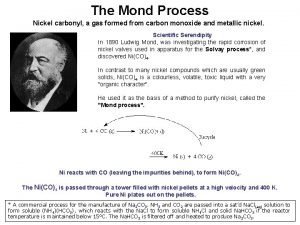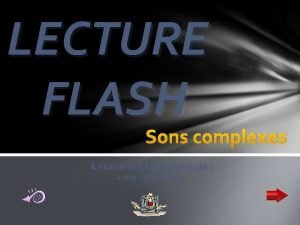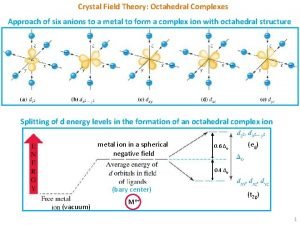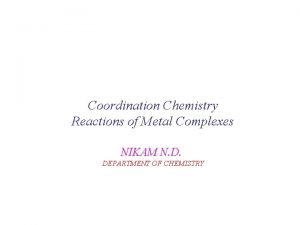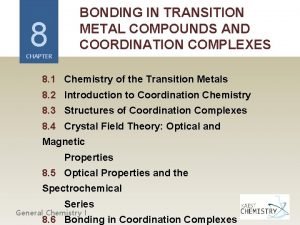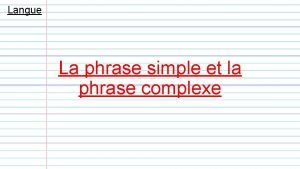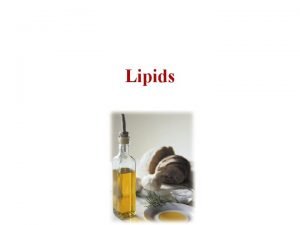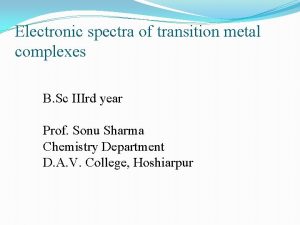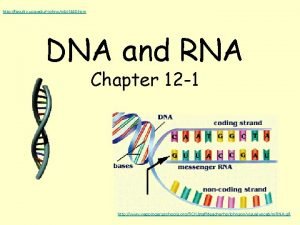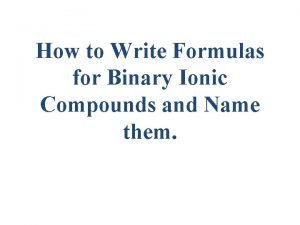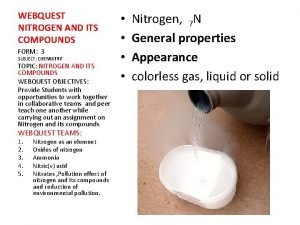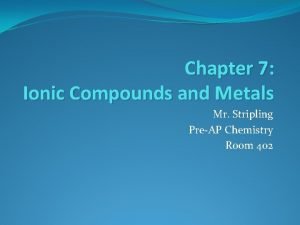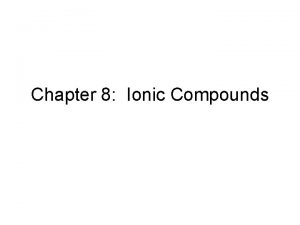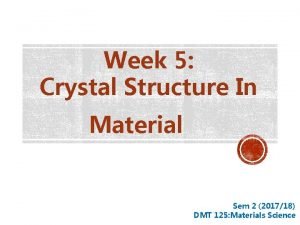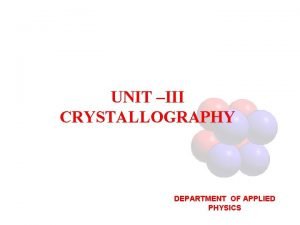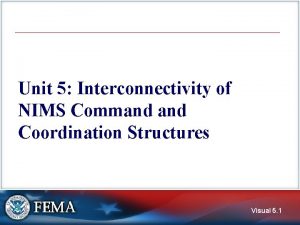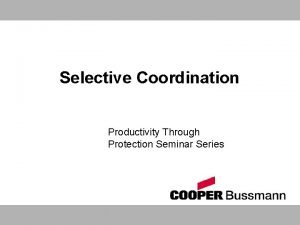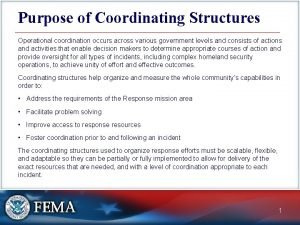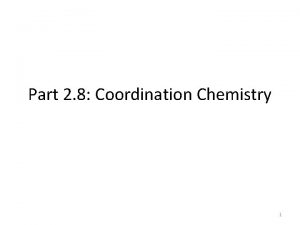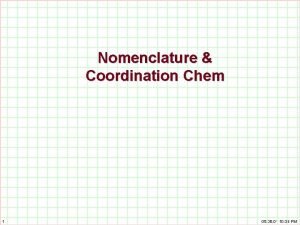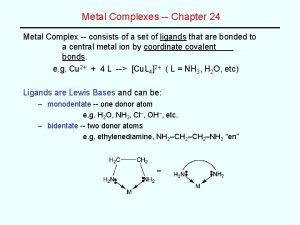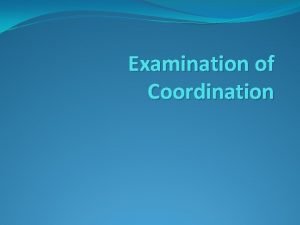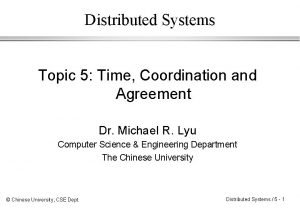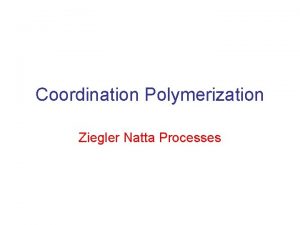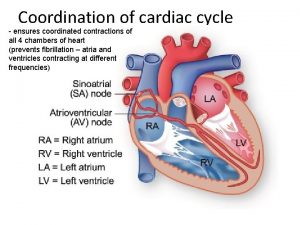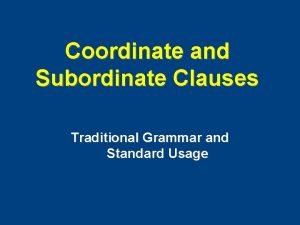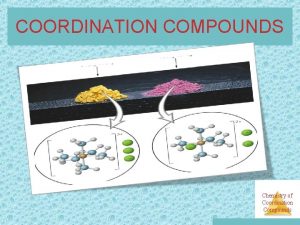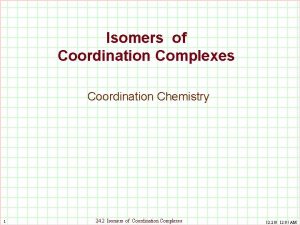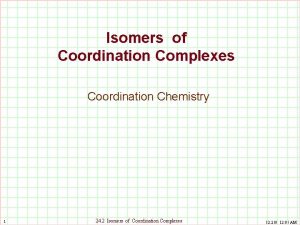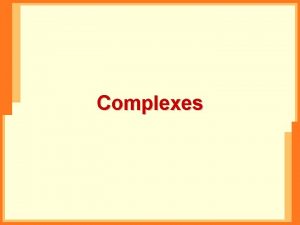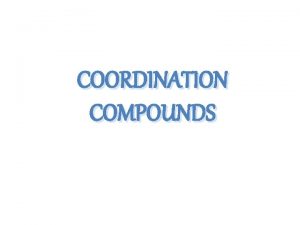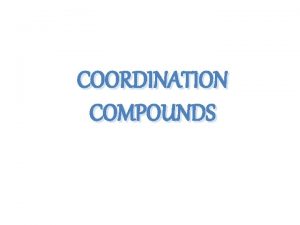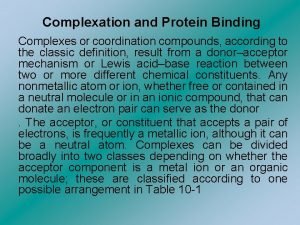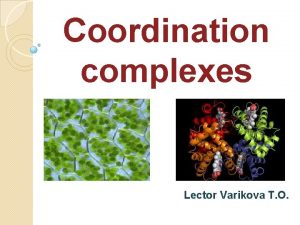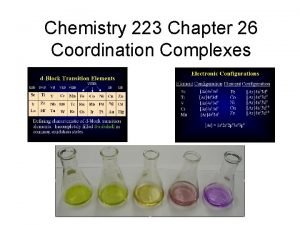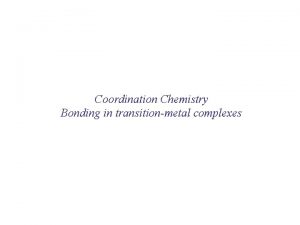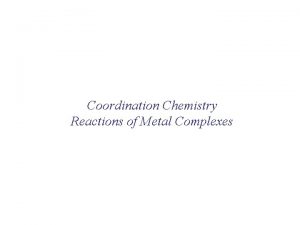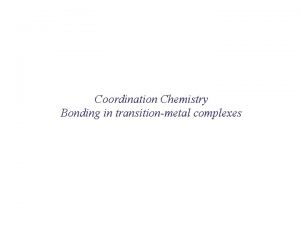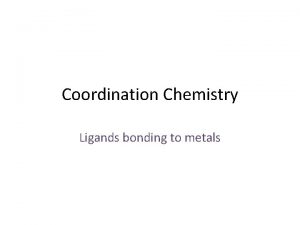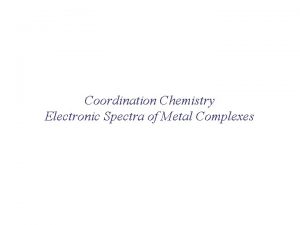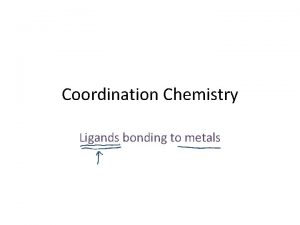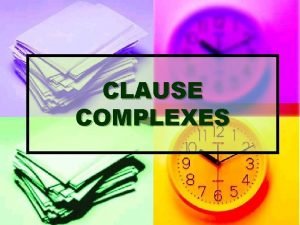Chapter 24 Chemistry of Coordination Compounds Complexes A












































![[Ti(H 2 O)6]3+ Absorbs in green yellow. Looks purple. Chemistry of Coordination Compounds [Ti(H 2 O)6]3+ Absorbs in green yellow. Looks purple. Chemistry of Coordination Compounds](https://slidetodoc.com/presentation_image/4f9905db3413467c2c94ec3facd31d9d/image-45.jpg)

































- Slides: 78

Chapter 24 Chemistry of Coordination Compounds

Complexes • A central metal atom bonded to a group of molecules or ions is a metal complex. • If it’s charged, it’s a complex ion. Chemistry of • Compounds containing complexes are coordination Compounds compounds.

Complexes • The molecules or ions coordinating to the metal are the ligands. • They are usually anions or polar molecules. • The must have lone pairs to interact with metal Chemistry of Coordination Compounds

A chemical mystery: Same metal, same ligands, different number of ions when dissolved • Many coordination compounds are brightly colored, but again, same metal, same ligands, different colors. Chemistry of Coordination Compounds

Werner’s Theory Co(III) oxidation state Coordination # is 6 • suggested in 1893 that metal ions have primary and secondary valences. Ø Primary valence equal the metal’s oxidation number Chemistry of Coordination Ø Secondary valence is the number of atoms directly Compounds bonded to the metal (coordination number)

Werner’s Theory • The central metal and the ligands directly bonded to it make up the coordination sphere of the complex. • In Co. Cl 3 ∙ 6 NH 3, all six of the ligands are NH 3 and the 3 chloride ions are outside the coordination sphere. Chemistry of Coordination Compounds

Werner’s Theory In Co. Cl 3 ∙ 5 NH 3 the five NH 3 groups and one chlorine are bonded to the cobalt, and the other two chloride ions are outside the sphere. Chemistry of Coordination Compounds

Werner’s Theory Werner proposed putting all molecules and ions within the sphere in brackets and those “free” anions (that dissociate from the complex ion when dissolved in water) outside the brackets. Chemistry of Coordination Compounds

Werner’s Theory • This approach correctly predicts there would be two forms of Co. Cl 3 ∙ 4 NH 3. Ø The formula would be written [Co(NH 3)4 Cl 2]Cl. Ø One of the two forms has the two chlorines next to each other. Ø The other has the chlorines opposite each other. Chemistry of Coordination Compounds

What is Coordination? • When an orbital from a ligand with lone pairs in it overlaps with an empty orbital from a metal M L Sometimes called a coordinate covalent bond So ligands must have lone pairs of electrons. Chemistry of Coordination Compounds

Metal-Ligand Bond • This bond is formed between a Lewis acid and a Lewis base. Ø The ligands (Lewis bases) have nonbonding electrons. Ø The metal (Lewis acid) has empty orbitals. Chemistry of Coordination Compounds

Metal-Ligand Bond The metal’s coordination ligands and geometry can greatly alter its properties, such as color, or ease of oxidation. Chemistry of Coordination Compounds

Oxidation Numbers Knowing the charge on a complex ion and the charge on each ligand, one can determine the oxidation number for the metal. Chemistry of Coordination Compounds

Oxidation Numbers Or, knowing the oxidation number on the metal and the charges on the ligands, one can calculate the charge on the complex ion. Example: Cr(III)(H 2 O)4 Cl 2 Chemistry of Coordination Compounds

Coordination Number • The atom that supplies the lone pairs of electrons for the metal-ligand bond is the donor atom. • The number of these atoms is the coordination number. Chemistry of Coordination Compounds

Coordination Number • Some metals, such as chromium(III) and cobalt(III), consistently have the same coordination number (6 in the case of these two metals). • The most commonly encountered numbers are 4 and 6. Chemistry of Coordination Compounds

Geometries • There are two common geometries for metals with a coordination number of four: Ø Tetrahedral Ø Square planar Tetrahedral Square planar Why square planar? We’ll get to that Chemistry of Coordination Compounds

Geometries By far the mostencountered geometry, when the coordination number is six, is octahedral. Chemistry of Coordination Compounds

Polydentate Ligands • Some ligands have two or more donor atoms. • These are called polydentate ligands or chelating agents. • In ethylenediamine, NH 2 CH 2 NH 2, represented here as en, each N is a donor atom. • Therefore, en is bidentate. Chemistry of Coordination Compounds

Polydentate Ligands Ethylenediaminetetraacetate, mercifully abbreviated EDTA, has six donor atoms. Wraps around the central atom like an octopus Chemistry of Coordination Compounds

Polydentate Ligands Chelating agents generally form more stable complexes than do monodentate ligands. Chemistry of Coordination Compounds

Chelating Agents 5 -. . : . . : - : : . . - • Bind to metal ions removing them from solution. • Phosphates are used to tie up Ca 2+ and Mg 2+ in hard water to prevent them from interfering with Chemistry of detergents. Coordination Compounds

Chelating Agents • Porphyrins are complexes containing a form of the porphine molecule shown at right. • Important biomolecules like heme and chlorophyll are porphyrins. Chemistry of Coordination Compounds

Chelating Agents Porphines (like chlorophyll a) are tetradentate ligands. Chemistry of Coordination Compounds

Nomenclature of Coordination Compounds • The basic protocol in coordination nomenclature is to name the ligands attached to the metal as prefixes before the metal name. • Some common ligands and their names are listed Chemistry of Coordination above. Compounds

Nomenclature of Coordination Compounds • As always the name of the cation appears first; the anion is named last. • Ligands are listed alphabetically before the metal. Prefixes denoting the number of a particular ligand are ignored when alphabetizing. Chemistry of Coordination Compounds

Nomenclature of Coordination Compounds • The names of anionic ligands end in “o”; the endings of the names of neutral ligands are not changed. • Prefixes tell the number of a type of ligand in the complex. If the name of the ligand itself has such a prefix, alternatives like bis-, tris-, etc. , are used. Chemistry of Coordination Compounds

Nomenclature of Coordination Compounds • If the complex is an anion, its ending is changed to -ate. • The oxidation number of the metal is listed as a Roman numeral in parentheses immediately after the name of the metal. Chemistry of Coordination Compounds

Isomers have the same molecular formula, but their atoms are arranged either in a different order (structural isomers) or spatial arrangement Chemistry of Coordination (stereoisomers). Compounds

Structural Isomers If a ligand (like the NO 2 group at the bottom of the complex) can bind to the metal with one or another atom as the donor atom, linkage isomers are formed. Chemistry of Coordination Compounds

Structural Isomers • Some isomers differ in what ligands are bonded to the metal and what is outside the coordination sphere; these are coordination-sphere isomers. • Three isomers of Cr. Cl 3(H 2 O)6 are ØThe violet [Cr(H 2 O)6]Cl 3, ØThe green [Cr(H 2 O)5 Cl]Cl 2 ∙ H 2 O, and ØThe (also) green [Cr(H 2 O)4 Cl 2]Cl ∙ 2 H 2 O. Chemistry of Coordination Compounds

Geometric isomers • With these geometric isomers, two chlorines and two NH 3 groups are bonded to the platinum metal, but are clearly different. Øcis-Isomers have like groups on the same side. Øtrans-Isomers have like groups on opposite sides. # of each atom the same Bonding the same Arrangement in space different Chemistry of Coordination Compounds

Stereoisomers • Other stereoisomers, called optical isomers or enantiomers, are mirror images of each other. • Just as a right hand will not fit into a left glove, two enantiomers cannot be superimposed on Chemistry of Coordination each other. Compounds

Enantiomers A molecule or ion that exists as a pair of enantiomers is said to be chiral. Chemistry of Coordination Compounds

Enantiomers • Most of the physical properties of chiral molecules are the same, boiling point, freezing point, density, etc. • One exception is the interaction of a chiral molecule with plane-polarized light. Chemistry of Coordination Compounds

Enantiomers • If one enantiomer of a chiral compound is placed in a polarimeter and polarized light is shone through it, the plane of polarization of the light will rotate. • If one enantiomer rotates the light 32° to the right, the other will rotate it 32° to the left. Chemistry of Coordination Compounds

Chemistry of Coordination Compounds

Chemistry of Coordination Compounds

Chemistry of Coordination Compounds

Explaining the properties of transition metal coordination complexes 1. Magnetism 2. color Chemistry of Coordination Compounds

Metal complexes and color The ligands of a metal complex effect its color Chemistry of Coordination Compounds Addition of NH 3 ligand to Cu(H 2 O)4 changes its color

Why does anything have color? Light of different frequencies give different colors We learned that elements can emit light of different frequency or color. But these coordination complexes are not emitting light They absorb light. How does that give color? Chemistry of Coordination Compounds

Light can bounce off an object or get absorbed by object No light absorbed, all reflected get white color All light absorbed, none reflected get Black color What if only one color is absorbed? Chemistry of Coordination Compounds

Complimentary color wheel If one color absorbed, the color opposite is perceived. Absorb Orange See Blue Absorb Red See Green Chemistry of Coordination Compounds
![TiH 2 O63 Absorbs in green yellow Looks purple Chemistry of Coordination Compounds [Ti(H 2 O)6]3+ Absorbs in green yellow. Looks purple. Chemistry of Coordination Compounds](https://slidetodoc.com/presentation_image/4f9905db3413467c2c94ec3facd31d9d/image-45.jpg)
[Ti(H 2 O)6]3+ Absorbs in green yellow. Looks purple. Chemistry of Coordination Compounds

A precise measurement of the absorption spectrum of Compounds is critical Chemistry of Coordination Compounds

Metal complexes and color But why do different ligands on same metal give Different colors? Why do different ligands change absorption? Chemistry of Coordination Compounds Addition of NH 3 ligand to Cu(H 2 O)4 changes its color

Model of ligand/metal bonding. Electron pair comes from ligand Bond very polarized. Assumption: interaction pure electrostatic. Chemistry of Coordination Compounds

Now, think of point charges being attracted to metal nucleus Positive charge. What about electrons in d orbitals? Ligand negative charge Is repelled by d electrons, d orbital energy goes up Chemistry of Coordination Compounds

Ligands will interact with some d orbitals more than others Depends on relative orientation of orbital and ligand Ligands point right at lobes Chemistry of Coordination Compounds

In these orbitals, the ligands are between the lobes Interact less strongly Chemistry of Coordination Compounds

Splitting due to ligand/orbirtal orientation. Chemistry of Coordination Compounds

= 495 nm Chemistry of Coordination Compounds

Different ligands interact more or less, change E spacing Of D orbitals. Chemistry of Coordination Compounds

Spectrochemical series (strength of ligand interaction) Increasing Cl- < F- < H 2 O < NH 3 < en < NO 2 - < CN- Increasing Chemistry of Coordination Compounds

Electron configurations of some octahedral complexes Chemistry of Coordination Compounds

As Energy difference increases, electron configuration changes “Low spin” “High spin” Co(III) is d 6 Chemistry of Coordination Compounds

Chemistry of Coordination Compounds

Tetrahedral Complexes In tetrahedral complexes, orbitals are inverted. Again because of orientation of orbitals and ligands is always small, always low spin (less ligands) Chemistry of Coordination Compounds

Square planar complexes are different still Chemistry of Coordination Compounds

Chemistry of Coordination Compounds

Chemistry of Coordination Compounds

Intense color can come from “charge transfer” Ligand electrons jump to metal orbitals KMn. O 4 KCr. O 4 KCl. O 4 No d orbitals in Cl, orbitals higher In energy Chemistry of Coordination Compounds

Chemistry of Coordination Compounds

Exam 4, MO theory and coordination compounds Chapter 9, end and Chapter 24. MO theory: Rules: • 1. The number of MO’s equals the # of Atomic orbitals • 2. The overlap of two atomic orbitals gives two molecular orbitals, 1 bonding, one antibonding • 3. Atomic orbitals combine with other atomic orbitals of similar energy. • 4. Degree of overlap matters. More overlap means bonding orbital goes lower in E, antibonding orbital goes higher in E. • 5. Each MO gets two electrons • 6. Orbitals of the same energy get filled 1 electron at a time until they are filled. Chemistry of Coordination Compounds

Difference between pi and sigma orbitals End on Side to side. Chemistry of Coordination Compounds

A typical MO diagram, like the one below. For 2 p and 2 s atomic orbital mixing. Chemistry of Coordination Compounds

Oxygen O 2 is Paramagnetic, why? Chemistry of Coordination Compounds

Show me why. Chemistry of Coordination Compounds

Exam 4 Chapter 24. Concentrate on the homeworks and the quiz! Terms: 1. Coordination sphere 2. Ligand 3. Coordination compound 4. Metal complex 5. Complex ion 6. Coordination 7. Coordination number Same ligands different properties? Figuring oxidation number on metal Chemistry of Coordination Compounds

Polydentate ligands (what are they)? Isomers. structural isomers (formula same, bonds differ) geometric isomers (formula AND bonds same, structure differs) Stereoisomers: Chirality, handedness, Chemistry of Coordination Compounds

Chemistry of Coordination Compounds

Stereoisomers Chemistry of Coordination Compounds

Explaining the properties of metal complexes Magnetism and color How does seeing color work? Absorb Orange See Blue Absorb Red See Green Chemistry of Coordination Compounds

Different ligands on same metal give different colors Addition of NH 3 ligand to Cu(H 2 O)4 changes its color Chemistry of Coordination Compounds

Splitting of d orbitals in an oxtahedral ligand field d z 2 dxy dx 2 -y 2 dyz dxz Chemistry of Coordination Compounds

Spectrochemical series (strength of ligand interaction) Increasing Cl- < F- < H 2 O < NH 3 < en < NO 2 - < CN- Increasing Know low spin versus high spin Chemistry of Coordination Compounds

There is also splitting from tetrahedral And square planar. Know they are different, don’t remember exactly what they are like. Chemistry of Coordination Compounds
 Complexes of the type m(aa)3 ±n show
Complexes of the type m(aa)3 ±n show Coordination compound nomenclature
Coordination compound nomenclature Werners theory of coordination compounds
Werners theory of coordination compounds Coordination sphere example
Coordination sphere example Werner coordination number
Werner coordination number Vbt was proposed by
Vbt was proposed by Microstate table for p2
Microstate table for p2 Electronic spectra of coordination compounds
Electronic spectra of coordination compounds Correlation diagram in coordination chemistry
Correlation diagram in coordination chemistry Drawing coordination compounds
Drawing coordination compounds Define geometrical isomerism
Define geometrical isomerism Ferric alum as a double salt
Ferric alum as a double salt Ionic vs covalent venn diagram
Ionic vs covalent venn diagram Correlation diagram in coordination chemistry
Correlation diagram in coordination chemistry Coordination number
Coordination number Mond carbonyl process
Mond carbonyl process K complex eeg
K complex eeg The electra complex
The electra complex Labile and inert complexes examples
Labile and inert complexes examples Voyelles complexes
Voyelles complexes Electron transport chain complexes
Electron transport chain complexes δo
δo Inert and labile complexes
Inert and labile complexes Actinide contraction
Actinide contraction Inert and labile complexes
Inert and labile complexes Descobriment de la roda
Descobriment de la roda Phrase complexe
Phrase complexe Spherical complexes of emulsified fats are known as
Spherical complexes of emulsified fats are known as Racah parameter
Racah parameter Limitations of orgel energy level diagram
Limitations of orgel energy level diagram Activated complex
Activated complex Modular man camps
Modular man camps A ________ is formed from beadlike histone-dna complexes.
A ________ is formed from beadlike histone-dna complexes. How to name ionic compounds
How to name ionic compounds Klb chemistry book 3 nitrogen and its compounds
Klb chemistry book 3 nitrogen and its compounds Prop but pent
Prop but pent Organic chemistry nomenclature
Organic chemistry nomenclature Ionic compounds
Ionic compounds 7 ionic and metallic bonding practice problems
7 ionic and metallic bonding practice problems Ib chemistry organic chemistry
Ib chemistry organic chemistry Inorganic chemistry vs organic chemistry
Inorganic chemistry vs organic chemistry Chapter 7 chemical formulas and chemical compounds test
Chapter 7 chemical formulas and chemical compounds test Modern chemistry chapter 7 test answer key
Modern chemistry chapter 7 test answer key Ionic compounds and metals chapter 7
Ionic compounds and metals chapter 7 Chapter 6 section 1 atoms elements and compounds answer key
Chapter 6 section 1 atoms elements and compounds answer key Chapter 7 ionic compounds and metals assessment answer key
Chapter 7 ionic compounds and metals assessment answer key Chapter 6 section 1 atoms elements and compounds
Chapter 6 section 1 atoms elements and compounds Monotomic ion
Monotomic ion Volume of bcc unit cell
Volume of bcc unit cell Indot unique special provisions
Indot unique special provisions Crystallography engineering physics
Crystallography engineering physics Mac group nims
Mac group nims Coordination is the ability
Coordination is the ability Coordination in grammar
Coordination in grammar Selective coordination definition
Selective coordination definition Selective coordination
Selective coordination What is the tribal assistance coordination group (tac-g)?
What is the tribal assistance coordination group (tac-g)? Compatibility configuration coordination control
Compatibility configuration coordination control Ligand field strength order
Ligand field strength order Subordination outline
Subordination outline Co ordination number
Co ordination number Global information system
Global information system D orbital shape
D orbital shape Concept de coordination
Concept de coordination Perbedaan kalimat majemuk dan tunggal
Perbedaan kalimat majemuk dan tunggal 1980-1896
1980-1896 Which is an example of faulty coordination
Which is an example of faulty coordination Conversational coordination example
Conversational coordination example Non equilibrium coordination test grading
Non equilibrium coordination test grading Coordination and agreement in distributed system
Coordination and agreement in distributed system Meaning
Meaning Ziegler-natta coordination polymerization
Ziegler-natta coordination polymerization Equilibrium and non equilibrium test
Equilibrium and non equilibrium test Coordination of services team
Coordination of services team Coordination of cardiac cycle
Coordination of cardiac cycle Types of clauses
Types of clauses Coordination in leadership
Coordination in leadership Balance skill related fitness
Balance skill related fitness Pathways community hub model
Pathways community hub model

